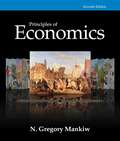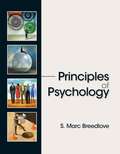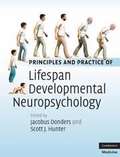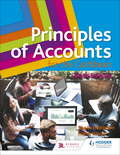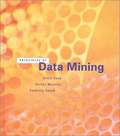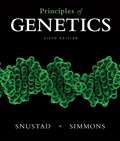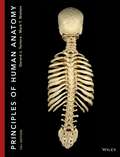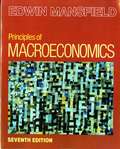- Table View
- List View
Primate Comparative Anatomy
by Daniel L. GeboA comprehensive, illustrated textbook that reveals the structural and functional anatomy of primates.Winner of the CHOICE Outstanding Academic Title of the Choice ACRLWhy do orangutan arms closely resemble human arms? What is the advantage to primates of having long limbs? Why do primates have forward-facing eyes? Answers to questions such as these are usually revealed by comparative studies of primate anatomy.In this heavily illustrated, up-to-date textbook, primate anatomist Daniel L. Gebo provides straightforward explanations of primate anatomy that move logically through the body plan and across species. Including only what is essential in relation to soft tissues, the book relies primarily on bony structures to explain the functions and diversity of anatomy among living primates. Ideal for college and graduate courses, Gebo's book will also appeal to researchers in the fields of mammalogy, primatology, anthropology, and paleontology.Included in this book are discussions of:• Phylogeny• Adaptation• Body size• The wet- and dry-nosed primates• Bone biology• Musculoskeletal mechanics• Strepsirhine and haplorhine heads• Primate teeth and diets• Necks, backs, and tails• The pelvis and reproduction• Locomotion• Forelimbs and hindlimbs• Hands and feet• Grasping toes
Primates in Perspective (2nd Edition)
by Agustin Fuentes Christina J. Campbell Katherine C. Mackinnon Rebecca M. Stumpf Simon K. BearderFeaturing forty-seven original essays by seventy leading researchers, Primates in Perspective, Second Edition, offers a comprehensive and contemporary overview of all major areas of primatology. Thoroughly revised and updated throughout, the second edition offers a diversity of theoretical positions on such topics as reproduction, ecology, and social behavior and intelligence. Primates in Perspective, Second Edition, is ideal for introductory primatology courses and can also be used in upper-division behavior and conservation courses. Additionally, it is an essential reference for primate researchers.
Primavera
by Mary Jane BeaufrandThe Italian Renaissance was a cultural explosion of art, architecture and learning, but it had a darker side. Two powerful families, the tyrannical Medici and their biggest rivals, the Pazzi, are tangled in a bloody struggle for ultimate power. Caught in the whirlwind is Flora, the last daughter of the Pazzi. As her beautiful older sister is being painted by the famed artist Botticelli, Flora is dreading her fate. Destined for life in a convent, Flora is determined to take matters into her own hands, even as her world crumbles around her. When Flora decides runs away, she has no idea that the decision will save her life. As her family falls to their murderous enemy, Flora must find a new life and a new identity.Inspired by actual events, Primavera is a dazzling coming of age story set during a time of beauty and wealth, ambition, rivalry and brutality. Historical art references to Boticelli and his famous painting, Primavera, give this book an appeal similar to Girl with a Pearl Earring.
Prince Caspian: The Return to Narnia (Chronicles of Narnia #4)
by C. S. LewisIllustrations in this ebook appear in vibrant full color on a full-color ebook device and in rich black and white on all other devices.Narnia . . . where animals talk . . . where trees walk . . . where a battle is about to begin.A prince denied his rightful throne gathers an army in a desperate attempt to rid his land of a false king. But in the end, it is a battle of honor between two men alone that will decide the fate of an entire world.Prince Caspian is the fourth book in C. S. Lewis’s The Chronicles of Narnia, a series that has become part of the canon of classic literature, drawing readers of all ages into a magical land with unforgettable characters for over sixty years. This is a stand-alone novel, but if you would like to see more of Lucy and Edmund’s adventures, read The Voyage of the Dawn Treader, the fifth book in The Chronicles of Narnia.
Prince of Fortune
by Lisa TirrenoRed, White & Royal Blue meets A Darker Shade of Magic in this swoony debut young adult romantic fantasy following a magical young prince and a noble seer who fall in love in the midst of war and intrigue.Shy Prince Edmund will be a great king one day: it has been Seen again and again. With rare magic giving him dominion over the nation&’s plants and weather, Edmund feels a great deal of pressure to live up to his nation&’s many expectations, including making a perfect diplomatic alliance through marriage. That is, until he meets Lord Aubrey Ainsley. Charming, romantic, and politically insignificant, Aubrey is a Seer, but not even he could have predicted catching the eye of Edmund, the Prince of Fortune—nor that the anxious prince who talks to plants more than people could feel so right for him. Aubrey&’s dream-visions have been full of battle, not love, but to say that Prince Edmund has captured his fancy would be a grand understatement. As the two become more and more intertwined, the nation of Saben falls under attack. War and dark sorcery loom on the horizon. To save their homeland, Edmund and Aubrey must resist the outside forces seeking to drive them apart and find the power within themselves to create a future for Saben—and each other—they never could have imagined.
Prince of the Palisades
by Julian WintersYoung Royals meets Red, White, and Royal Blue in this heart-pumping romance by award-winning author Julian Winters!When roguish Prince Jadon of Îles de la Rêverie is left in America to clean up his image after a horribly public break-up gone viral, romance is not on the table. Carefully planned photo ops with puppies? Yes. Scheduled appearances with the Santa Monica elite? Absolutely. Rendezvous with a pink-haired, film-obsessed hottie from the private school where he&’s currently enrolled? Uhhhh… Together with his entourage—a bitingly witty royal guard, Rêverie&’s future queen (and Jadon&’s brilliant older sister), and a quirky royal liaison—Jadon&’s on a mission to turn things around and show his parents, and his country, that he&’s more than just a royal screw-up. If he doesn&’t prove that he&’s the prince Rêverie deserves? Well, he may not be allowed home… But falling for a not-so-royal American boy has Jadon redefining what it means to be a leader. If he can be someone&’s Prince Charming just by being himself, maybe that&’s all it takes to win over a nation. Or at least a prince can dream…
Principles Of Economics 7th Edition
by N. Gregory MankiwWith its clear and engaging writing style, PRINCIPLES OF ECONOMICS, Seventh Edition, continues to be one of the most popular books on economics available today. Mankiw emphasizes material that you are likely to find interesting about the economy (particularly if you are studying economics for the first time), including real-life scenarios, useful facts, and the many ways economic concepts play a role in the decisions you make every day.
Principles Of Microeconomics
by Robert H. Frank Ben BernankeA book that encourages students become "economic naturalists," people who employ basic economic principles to understand and explain what they observe in the world around them.
Principles Of Psychology
by S. Marc BreedloveOrganized around four well-established core principles, Principles of Psychology provides students with a framework to understand the science of behavior. Written in a conversational style, the text is organized around the following four well-established principles that serve as touchstones for the field of psychology: --The mind is a process at work in a physical machine, the brain. --We are consciously aware of only a fraction of our mental activity. --We constantly modify our behavior, beliefs, and attitudes according to what we perceive about the people around us. --Experience physically alters the structure and function of the brain. With these four principles as a framework for the text, Principles of Psychology emphasizes that psychology is a science through discussion of relevant big-picture and proven concepts and cutting-edge research-based investigations that examine behavioral, psychological, and neuroscience experiments. By presenting data and facts from other scientific disciplines, as well as real-world vignettes and stories, Marc Breedlove teaches the reader how to think critically and scientifically about the underlying mechanisms of behavior. In-Text Features --Vignette: Each chapter begins with a story, an instance when behavior has a big impact on someone's life. The chapter returns to the vignette several times as we cover findings that relate to that particular case. --Researchers at Work: In every chapter, important discoveries are explained and illustrated to highlight the process of experimentation and hypothesis testing. Over the course of the book, the progression of experiments provides an increasingly sharper picture of the factors shaping behavior. --Skeptic at Large: Intended to sharpen the student's critical thinking skills, these boxes explore a widespread misconception and demonstrate how scientific research disproves it. The exploration of scientific experimentation also reinforces the Researchers at Work feature. --Psychology in Everyday Life: These are topics where knowledge of psychology might be applicable to everyday life, such as whether people with schizophrenia are violent, the importance of "blind" auditions for musicians, how to stop smoking, or how conditioned taste aversion might cause you to stop eating sushi when you used to love it. --The Cutting Edge: Just prior to the end of every chapter, this feature explores an exciting report of current research. Showing students these vibrant and bold experiments will emphasize that psychology research remains alive and well. --Think Like a Psychologist: Principles in Action: To close each chapter, each principle is related back to the vignette to show the student that when they observe an interesting behavior they can recall and apply the four principles. If they can do this, they will indeed be thinking like a psychologist.
Principles and Applications of Assessment in Counseling (4th Edition)
by Susan C. WhistonThis text, created specifically for counseling students, provides with a comprehensive introduction to appraisal and assessment and focuses on the importance of using assessment results to evaluate the efficacy of counseling. With cases studies found throughout, students will easily learn to apply principles to real life.
Principles and Practice of Grief Counseling
by Darcy L. Harris Howard R. WinokuerThis core, introductory textbook for undergraduate and graduate level courses is the first volume to combine the knowledge and skills of counseling psychology with current theory and research in grief and bereavement. It is grounded in the belief that grief counseling is distinct from other therapeutic issues because grief is an adaptive response rather than a form of pathology. The book describes the unique aspects of grief as a normal response to loss, and views the goal of counseling bereaved individuals as one of facilitating the unfolding of the healthy and adaptive aspects of the process as it manifests itself within each client. Grief is considered a response to losses that are both death- and non-death-related; and psychological, physical, social, economical and practical experiences of grief are addressed. The text introduces various theories of bereavement and examines different therapeutic modalities that can be used in the context of grief and loss. Specific counseling practices that facilitate successful interventions are discussed, particularly that of "presence," considered by the authors to be the primary therapeutic stance when working with bereaved individuals. The text also addresses grief counseling with special populations, ethical issues, and self-care concerns for counselors. Case studies, discussion and reflection questions, and suggested additional resources are included in each chapter.
Principles and Practice of Lifespan Developmental Neuropsychology
by Jacobus Donders Scott J. HunterLifespan developmental neuropsychology is the study of the systematic behavioral, cognitive, and psychosocial changes and growth that occur across infancy, adolescence, adulthood and later life. This book provides insight into how brain-behavior relationships change over time, how disorders differ in presentation across the lifespan, and what longer-term outcomes look like. Providing practical guidance in a succinct and accessible format, this book covers the most common neurodevelopmental, behavioral and cognitive disorders, including but not limited to ADHD, cerebral palsy, traumatic brain injury, and epilepsy. Key points concerning the practice of developmental neuropsychology are emphasized in order to aid understanding of neuropsychological development and its impact on behavior, emotion, cognition, and social integration. This will be essential reading for advanced graduate students and early career professionals in the fields of neuropsychology, pediatric psychology, clinical psychology, school psychology, and rehabilitation psychology, as well as practitioners in the allied fields that interact with neuropsychology.
Principles of Accounts for the Caribbean: 6th Edition Epub
by Sheila Robinson Elaine Mayall Andrienne JonesGuide students through the new syllabus with a full-colour, revised edition of a well-known and trusted title, and prepare them for post-secondary and professional studies in Accounting.- Ensure students understand a range of theoretical and practical techniques used in accounting. - Enable students to participate more effectively and responsibly in today's business environment and improve management of budgeting, savings and investment. - Navigate the revised syllabus with ease with a book matching the structure and coverage, as well as including a detailed section on the Student Based Assessment with an annotated example to help students when planning their own. - Prepare for examinations with the 'Helpful hints' feature, containing study tips, practice tips and examiner tips; practice questions are also included in the Student eTextbook. - Make topics relatable with case studies included.
Principles of Data Mining
by David J. Hand Heikki Mannila Padhraic SmythThe growing interest in data mining is motivated by a common problem across disciplines: how does one store, access, model, and ultimately describe and understand very large data sets? Historically, different aspects of data mining have been addressed independently by different disciplines. This is the first truly interdisciplinary text on data mining, blending the contributions of information science, computer science, and statistics. The book consists of three sections. The first, foundations, provides a tutorial overview of the principles underlying data mining algorithms and their application. The presentation emphasizes intuition rather than rigor. The second section, data mining algorithms, shows how algorithms are constructed to solve specific problems in a principled manner. The algorithms covered include trees and rules for classification and regression, association rules, belief networks, classical statistical models, nonlinear models such as neural networks, and local "memory-based" models. The third section shows how all of the preceding analysis fits together when applied to real-world data mining problems. Topics include the role of metadata, how to handle missing data, and data preprocessing.
Principles of Economics Version 2.0
by Libby Rittenberg Timothy TregarthenIn the macro chapters of Version 2.0 of Principles of Economics thoroughly incorporates the recent recession and recovery-- placing it in historical and theoretical context and not shying away from the controversies surrounding how government responded to it. In the micro chapters, all the time-sensitive data has been updated, along with over half of all the "Start Ups" and "Case and Point" applications being brand new or updated. Flat World Knowledge is thrilled to publish a re-launch of Tim Tregarthen's acclaimed Principles of Economics V. 2.0 book, and proud to bring Tim's remarkable talents as a teacher to future generations of students.
Principles of Economics v 1.1
by Libby Rittenberg Timothy TregarthenVersion 1.1 boasts improved coverage throughout the text including significant updates to: Chapters 20 (GDP, Price Level Changes, Business Cycles, and Unemployment) Chapter 21 (Measuring Total Output and Income) Chapter 27 (Government and Fiscal Policy) Chapter 32 (Macroeconomics for the 21st Century).
Principles of General Chemistry (Second Edition)
by Martin S. SilberbergSilberberg’s Principles of General Chemistry offers students the same authoritative topic coverage as its parent text, Chemistry: The Molecular Nature of Matter and Change. The Principles text allows for succinct coverage of content with minimal emphasis on pedagogic learning aids. This more straightforward approach to learning appeals to today’s efficiency-minded, value-conscious instructors and students without sacrificing depth, clarity, or rigor.
Principles of Genetics (Sixth Edition)
by D. Peter Snustad Michael J. SimmonsSnustad's 6th edition of Principles of Genetics offers many new and advanced features including boxed sections with the latest advances in Genetics, a streamlined roster of topics, a more reader-friendly layout, and new problem-solving supplements. Furthermore, this new edition includes more problem solving within each chapter through the Test Your Problem Solving Skills feature and a Solve It icon to prompt readers to go online to WileyPlus for animated tutorials. A new one-column design better showcases important pieces of art and avoids the "overwhelmed" reaction readers have to the crowded layouts found in many other texts. Boxed sections reduce in size to help maintain the flow of the text and the Focus On boxes are revised to include the most current developments in genetics as well as most relevant topics.
Principles of Geoarchaeology: A North American Perspective
by Michael R. WatersPresents the basics of geoarchaeology, through application of field techniques to a study of the late Quaternary of America. Alluvial, terrestrial and coastal environments are considered, as well as post burial physical disturbances of archaeological sites.
Principles of Group Solidarity
by Michael HechterSocial scientists have long recognized that solidarity is essential for such phenomena as social order, class, and ethnic consciousness, and the provision of collective goods. In presenting a new general theory of group solidarity, Michael Hechter here contends that it is indeed possible to build a theory of solidarity based on the action of rational individuals and in doing so he goes beyond the timeworn disciplinary boundaries separating the various social sciences.
Principles of Human Anatomy
by Gerard J. Tortora Mark T. NielsenA market-leading text through its many editions, the 13th edition of Principles of Human Anatomy continues to successfully blend visual and textual elements to illuminate the complexities of human anatomy. Written for the 1-term human anatomy course, the 13th edition raises the standard for excellence in this discipline with its enhanced illustration program, refined narrative, and the integrated design of dynamic resources like Real Anatomy 2. 0 into the curriculum.
Principles of Macroeconomics
by Edwin MansfieldStudents will appreciate the accompanying Study Guide, prepared by Professor Mansfield himself. It contains Chapter Profiles, behavioral Objectives, Case Studies, Objective Questions, Discussion Questions, and Problems for each chapter in the textbook. A separate Computerized Study Guide with approximately 200 review questions and diagrams is also available.
Principles of Macroeconomics
by Libby Rittenberg Timothy TregarthenFlat World Knowledge is honored to publish a new, first edition re-launch of Tim Tregarthen's wonderful principles of macroeconomics book, and proud to bring Tim's incredible talents as a teacher back to life so future generations of students can continue to learn from him. In 1996, he published the first edition of his principles of microeconomics textbook to great acclaim, and it became widely used in colleges around the country. That same year, MS made him wheelchair-bound. The disease forced his retirement from teaching at the University of Colorado at Colorado Springs in 1998. He lost the use of his arms in 2001 and has been quadriplegic ever since. Tim never let his disease get him down. In fact, he turned back to his love of writing and teaching for inspiration. He obtained a voice-activated computer, recruited a co-author, Libby Rittenberg of Colorado College, and turned his attention to revising his principles of economics book. Today we are excited to introduce Libby Rittenberg and Timothy Tregarthen's Principles of Macroeconomics. The authors teach economics as the study of "choice " by providing students with an accessible, straightforward overview of economics. This text combines the clarity and writing of Tregarthen's seminal periodical "The Margin" with great teaching insights. Rittenberg and Tregarthen help students to understand how real individuals actually work with economics. In this new book, the authors illustrate the practicality and relevance of economics with a variety of new illustrations and insights. The authors take a three-pronged approach to every concept: (1) the concept is covered with a "Heads Up" to ward off confusion, (2) a "You Try It" section makes sure students are staying on top of the concept and (3) a "Case and Point" section that uses a real-world application to harness the concept in reality. For one example of how this plays out in the text see "Chapter 3, Section 2 on Supply".here This book is intended for a one-semester course in Macroeconomics taught out the social sciences or business school.
Principles of Macroeconomics (Eleventh Edition)
by Ray C. Fair Karl E. Case Sharon OsterCollege economics textbook.
Principles of Management
by Talya Bauer Mason Carpenter Berrin ErdoganPrinciples of Management by Carpenter, Bauer and Erdogan teaches management principles to tomorrow's business leaders by weaving three threads through every chapter: strategy, entrepreneurship and active leadership. Strategic: All business school teachings have some orientation toward performance and strategy and are concerned with making choices that lead to high performance. Principles of Management will frame performance using the notion of the triple bottom-line the idea that economic performance allows individuals and organizations to perform positively in social and environmental ways as well. The triple bottom line is financial, social, and environmental performance. It is important for all students to understand the interdependence of these three facets of organizational performance. The Entrepreneurial Manager: While the General Management course at Harvard Business School was historically one of its most popular and impactful courses (pioneered in the 1960s by Joe Bower), recent Harvard MBAs did not see themselves as general managers. This course was relabeled 'The Entrepreneurial Manager' in 2006, and has regained its title as one of the most popular courses. This reflects and underlying and growing trend that students, including the undergraduates this book targets, can see themselves as entrepreneurs and active change agents, but not just as managers. By starting fresh with an entrepreneurial/change management orientation, this text provides an exciting perspective on the art of management that students can relate to. At the same time, this perspective is as relevant to existing for-profit organizations (in the form intrapreneurship) as it is to not-for-profits and new entrepreneurial ventures. Active Leadership: Starting with the opening chapter, Principles of Management show students how leaders and leadership are essential to personal and organizational effectiveness and effective organizational change. Students are increasingly active as leaders at an early age, and are sometimes painfully aware of the leadership failings they see in public and private organizations. It is the leader and leadership that combine the principles of management (the artist's palette, tools, and techniques) to create the art of management. Cases: Mason provides brief cases in his Instructors Manual for those who take a case approach to the course or who wish to incorporate cases. This book's modular format easily maps to a POLC course organization (Planning, Organizing, Leading, and Controlling, attributed to Henri Fayol (1949, General and industrial management. London. Pitman Publishing company), and suits the needs of most undergraduate or graduate course in Principles of Management.






